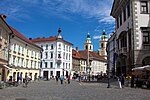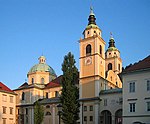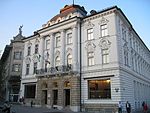Robba Fountain
Baroque architecture in SloveniaBaroque sculpturesBuildings and structures completed in 1751Buildings and structures in LjubljanaCenter District, Ljubljana ... and 2 more
Cultural monuments of SloveniaFountains in Slovenia

The Robba Fountain (Slovene: Robbov vodnjak), since the first half of the 20th century also known as the Fountain of the Three Carniolan Rivers (Vodnjak treh kranjskih rek), is the fountain that stands in front of Ljubljana Town Hall at Town Square in Ljubljana, the capital of Slovenia. It was originally made in 1751 by the Italian sculptor Francesco Robba and is one of the city's most recognisable symbols.
Excerpt from the Wikipedia article Robba Fountain (License: CC BY-SA 3.0, Authors, Images).Robba Fountain
Mestni trg, Ljubljana Trnovo
Geographical coordinates (GPS) Address Nearby Places Show on map
Geographical coordinates (GPS)
| Latitude | Longitude |
|---|---|
| N 46.050113888889 ° | E 14.506977777778 ° |
Address
Mestni trg
Mestni trg
Ljubljana, Trnovo
Slovenia
Open on Google Maps









